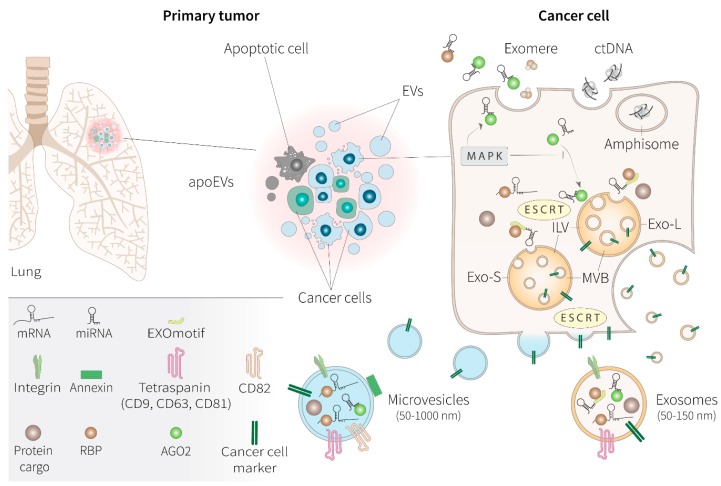Figure 1.
Biogenesis and heterogeneity of tumor-derived extracellular vesicles. A tumor mass is constituted of a heterogeneous population of cancer cells, constantly releasing a variety of extracellular vesicles (EVs), apoptotic bodies (apoEVs), and non-vesicular particles, including exomeres, all involved in the transport of nucleic acids and proteins that can have an active role in promoting tumor survival and aggressiveness. Cargo sorting into EVs involves the endosomal sorting complex required for transport (ESCRT) and partner proteins that include annexins (annexin A1) and tetraspanins (CD9, CD63, CD81, CD82). By reaching their destination exosome cargoes are sorted through the intraluminal vesicles (ILV), which form following the inward of endosomal membrane of the multivesicular bodies (MVBs) and are ultimately secreted upon fusion with the cell surface. Exosomes, similarly to microvesicles, display the same topology of membrane as the cell of origin and can potentially express cancer cell-specific markers. Microvesicles, however, generate from the outward budding of the plasma membrane. Different subsets of exosomes (large and small) with distinct molecular composition have been identified, along with the discovery of a population of abundant non-membranous nanoparticles involved in tumor growth, called exomeres. Exosomes are preferentially enriched with specific populations of miRNA, destined for exportation thanks to the presence of an EXOmotif, recognized by specialized RNA binding proteins (RBPs). During oncogenesis, activation of the mitogen-activated protein kinase (MAPK) pathway suppresses AGO2-mediated sorting of miRNAs to EVs, while favoring AGO2-independent EV loading of miRNAs and non-EV-associated miRNA release. Potentially, microvesicles can accommodate larger RNA species, including transcribing mRNAs. Nucleosomal double strand (dsDNA), although previously reported to be associated with exosomes, might not be directed to the ILVs, and it is instead released through EV-independent mechanisms involving intermediate organelles termed amphisomes. miRNA, microRNA; mRNA, messenger RNA; AGO-2, Argonaute 2; Exo-S, small exosome vesicles; Exo-L, large exosome vesicles.

